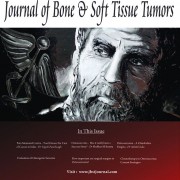Adamantinoma; An update
Vol 3 | Issue 2 | Sep-Dec 2017 | Page 16-19 | Ashish Gulia, Pankaj Kumar Panda.
Authors: Ashish Gulia [1], Pankaj Kumar Panda [1].
[1] Surgical Oncology (Orthopedic Oncology), 93, Ground Floor, Main Building, Bone & Soft tissue Services (Disease Management Group), Tata Memorial Hospital, Mumbai – 400012, India.
Address of Correspondence
Dr. Ashish Gulia,
Surgical Oncology (Orthopedic Oncology), 93, Ground Floor, Main Building, Bone & Soft tissue Services (Disease Management Group), Tata Memorial Hospital, Mumbai – 400012, India.
Email: aashishgulia@gmail.com
Abstract
Adamantinoma is a rare, malignant biphasic tumor with varied morphological patterns.Adamantinoma mostly occurs in the second to fifth decade and is slightly more common in men than women.The onset is insidious, and its course shows a slow, progressive character.Radiography is the initial and most reliable imaging modality for adamantinoma of bones because of the tumor’s classic location and appearance on a plain radiograph.Present management modalitieswhich includeen blocresection (mostly intercalary resection) with limb salvage and limb reconstruction. Chemotherapy and radiotherapy have no established role. Amputation does not improve survival but may be advisable in cases with local recurrence and in cases with few large, recurrent lesions where en bloc resection is not possible.
Keywords: Adamantinoma, malignant biphasic tumor, management.
References
1. Dahlin DC. Bone Tumors: General Aspects and Data on 6221 Cases. 3rded. Springfield, IL: Charles C Thomas; 1978. p. 296.
2. Kahn LB. Adamantinoma, osteofibrous dysplasia and differentiated adamantinoma. Skeletal Radiol 2003;32(5):245-258.
3. Fisher B. Primary adamantinoma of the tibia. Z Pathol 1913;12:422-441.
4. Van Rijn R, Bras J, Schaap G, van den Berg H, Maas M. Adamantinoma in childhood: Report of six cases and review of the literature. PediatrRadiol 2006;36(10):1068-1074.
5. Czerniak B, Rojas-Corona RR, Dorfman HD. Morphologic diversity of long bone adamantinoma. The concept of differentiated (regressing) adamantinoma and its relationship to osteofibrous dysplasia. Cancer 1989;64(11):2319-2334.
6. Mirra JM. Adamantinoma and fibrous dysplasia. InBone tumors 1sted. Mirra JM, editor. Philadelphia,PA: Lea &Febiger; 1989. p. 1203-1231.
7. Springfield DS, Rosenberg AE, Mankin HJ, Mindell ER. Relationship between osteofibrous dysplasia and adamantinoma. ClinOrthopRelat Res 1994;309:234-244.
8. Moon NF, Mori H. Adamantinoma of the appendicular skeleton-updated. ClinOrthopRelat Res 1986;204:215-237.
9. Lederer H, Sinclair AJ. Malignant synovioma simulating “adamantinoma of the tibia”. J PatholBacteriol 1954;67(1):163-168.
10. Van der Woude HJ, Hazelbag HM, Bloem JL, Taminiau AH, Hogendoorn PC. MRI of adamantinoma of long bones in correlation with histopathology. AJR Am J Roentgenol 2004;183(6):1737-1744.
11. Unni KK. Dahlin’s Bone Tumors: General Aspects and Data on 11,087 Cases. 5thed. Philadelphia, Pa: Lippincott-Raven; 1996. p. 333-342.
12. Hazelbag HM, Taminiau AHM, Fleuren GJ, Hogendoorn PC. Adamantinoma of the long bones. A clinicopathological study of thirty-two patients with emphasis on histologic subtype, precursor lesion, and biological behavior. J Bone Joint Surg Am 1994;76:1482-1499.
13. Weiss SW, Dorfman HD. Adamantinoma of long bone. An analysis of nine new cases with emphasis on metastasizing lesions and fibrous dysplasia-like changes. Hum Pathol 1977;8(2):141-153.
14. Bridge JA, Dembinski A, DeBoer J, Travis J, Neff JR. Clonal chromosomal abnormalities in osteofibrous dysplasia. Implications for histopathogenesis and its relationship with adamantinoma. Cancer 1994;73(6):1746-1752.
15. Ueda Y, Blasius S, Edel G, Wuisman P, Böcker W, Roessner A. Osteofibrous dysplasia of long bones-A reactive process to adamantinomatous tissue. J Cancer Res ClinOncol 1992;118(2):152-156.
16. Hazelbag HM, Fleuren GJ, vdBroek LJ, Taminiau AH, Hogendoorn PC. Adamantinoma of the long bones: Keratin subclass immunoreactivity pattern with reference to its histogenesis. Am J SurgPathol 1993;17(12):1225-1233.
17. Kanamori M, Antonescu CR, Scott M, Bridge RS Jr, Neff JR, Spanier SS, et al. Extra copies of chromosomes 7, 8, 12, 19, and 21 are recurrent in adamantinoma. J MolDiagn 2001;3(1):16-21.
18. Keeney GL, Unni KK, Beabout JW, Pritchard DJ. Adamantinoma of long bones. A clinicopathologic study of 85 cases. Cancer 1989;64(3):730-7.
19. Qureshi AA, Shott S, Mallin BA, Gitelis S. Current trends in the management of adamantinoma of long bones. An international study. J Bone Joint Surg Am 2000;82-A(8):1122-1131.
20. Bovée JV, van den Broek LJ, de Boer WI, Hogendoorn PC. Expression of growth factors and their receptors in adamantinoma of long bones and the implication for its histogenesis. J Pathol 1998;184(1):24-30.
| How to Cite this article: Gulia A, Panda P. Adamantinoma – an update. Journal of Bone and Soft Tissue Tumors Sep-Dec 2017;3(2): 16-19. |




